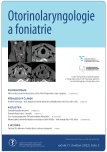-
Medical journals
- Career
Laryngeal fracture – a case report
Authors: T. Valenta 1; Michal Černý 1,2; Viktor Chrobok 1,2
Authors‘ workplace: Klinika otorinolaryngologie a chirurgie hlavy a krku, FN Hradec Králové 1; Univerzita Karlova, LF v Hradci Králové 2
Published in: Otorinolaryngol Foniatr, 71, 2022, No. 2, pp. 86-90.
Category: Case Reports
doi: https://doi.org/10.48095/ccorl202286Overview
Laryngeal injury is a rare condition that may threaten the patient’s life with airway obstruction. Early diagnostics is the key management factor. Schaefer’s classification is the most commonly used classification to assess the extent of the injury. Based on this classification, a recommended management of therapy has been developed. There are several opinions on securing the airway by the orotracheal intubation. The authors present a case report of a 40-year-old male with thyroid cartilage fracture caused by a punch to the neck. The patient did not show signs of dyspnoea, had swollen neck and subcutaneous emphysema. Imaging by computed tomography showed a laryngeal fracture. A reconstruction of the thyroid cartilage and a tracheostomy in general anaesthesia were performed. Postoperative course was propitious, and the patient could be decannulated. It is important to consider a laryngeal injury in patients with external neck trauma. The key elements are early diagnosis and therapy, in which securing the airway is the crucial step. Further an effort should be made to create conditions for preserving laryngeal functions (respiration, phonation, and swallowing).
Keywords:
Larynx – tracheostomy – laryngeal injury – laryngeal fracture
Sources
1. Lee WT, Eliashar R, Eliachar I. Acute external laryngotracheal trauma: diagnosis and management. Ear Nose Throat J 2006; 85 (3): 179–184. Doi: 10.1177/014556130608500 315.
2. Ribeiro-Costa N, Carneiro Sousa P, Abreu Pereira D et al. Laryngeal Fracture after Blunt Cervical Trauma in Motorcycle Accident and Its Management. Case Rep Otolaryngol 2017; 2017 : 9321975. Doi: 10.1155/2017/9321975.
3. Jalisi S, Zoccoli M. Management of laryngeal fractures – a 10-year experience. J Voice 2011; 25 (4): 473–479. Doi: 10.1016/j.jvoice.2009.12. 008.
4. Moonsamy P, Sachdeva UM, Morse CR. Management of laryngotracheal trauma. Ann Cardiothorac Surg 2018; 7 (2): 210–216. Doi: 10.21037/acs.2018.03.03.
5. Balai E, Bhamra N, Gupta KK et al. A Case of Laryngeal Fracture Precipitated by Swallowing. Cureus 2020; 12 (9): e10303. Doi: 10.7759/ cureus.10303.
6. Schaefer SD. Management of acute blunt and penetrating external laryngeal trauma. Laryngoscope 2014; 124 (1): 233–244. Doi: 10.1002/lary.24068.
7. Schaefer N, Griffin A, Gerhardy B et al. Early recognition and management of laryngeal fracture: a case report. Ochsner J 2014; 14 (2): 264–265.
8. Anniko M, Bernal-Sprekelsen M, Bonkow-sky V et al. Otorhinolaryngology, Head and Neck Surgery. Berlin, Heidelberg: Springer 2010.
9. Moser F, Dieroff HG, Kessler L et al. Oto-Rhino-Laryngologie: Erkrankungen der Nase, der Nasennebenhöhlen, des Rachens, des Kehlkopfes und der oberen Luft - und Speisewege / von 11 Fachautoren. Jena: Fischer; 1986.
10. Omakobia E, Micallef A. Approach to the Patient with External Laryngeal Trauma: The Schaefer Classification. Otolaryngol (Sunnyvale) 2016; 6 (2): 230. Doi: 10.4172/2161 - 119X.1000230.
11. Graham DB, Eastman AL, Aldy KN et al. Outcomes and long term follow-up after emergent cricothyroidotomy: is routine conversion to tracheostomy necessary? Am Surg 2011; 77 (12): 1707–1711. Doi: 10.1177/000313481107701248.
12. Francois B, Clavel M, Desachy A et al. Complications of tracheostomy performed in the ICU: subthyroid tracheostomy vs surgical cricothyroidotomy. Chest 2003; 123 (1): 151–158. Doi: 10.1378/chest.123.1.151.
Labels
Audiology Paediatric ENT ENT (Otorhinolaryngology)
Article was published inOtorhinolaryngology and Phoniatrics

2022 Issue 2-
All articles in this issue
- Editorial
- Sudden sensorineural hearing loss in children: a review of diagnosis, treatment, and prognosis
- Enhanced contact endoscopy – new diagnostic method of cancerous and precancerous lesions of head and neck mucosa
- Sinonasal teratocarcinosarcoma
- Laryngeal fracture – a case report
- Can residual cholesteatoma be detected by early postoperative DWI?
- Rare case of random cyanoacrylate glue application to the nose of a 4-year-old girl – management proposal
- Establishment of the ENT department in Považská Bystrica and its first protagonists
- Otorhinolaryngology and Phoniatrics
- Journal archive
- Current issue
- Online only
- About the journal
Most read in this issue- Laryngeal fracture – a case report
- Sudden sensorineural hearing loss in children: a review of diagnosis, treatment, and prognosis
- Enhanced contact endoscopy – new diagnostic method of cancerous and precancerous lesions of head and neck mucosa
- Sinonasal teratocarcinosarcoma
Login#ADS_BOTTOM_SCRIPTS#Forgotten passwordEnter the email address that you registered with. We will send you instructions on how to set a new password.
- Career

